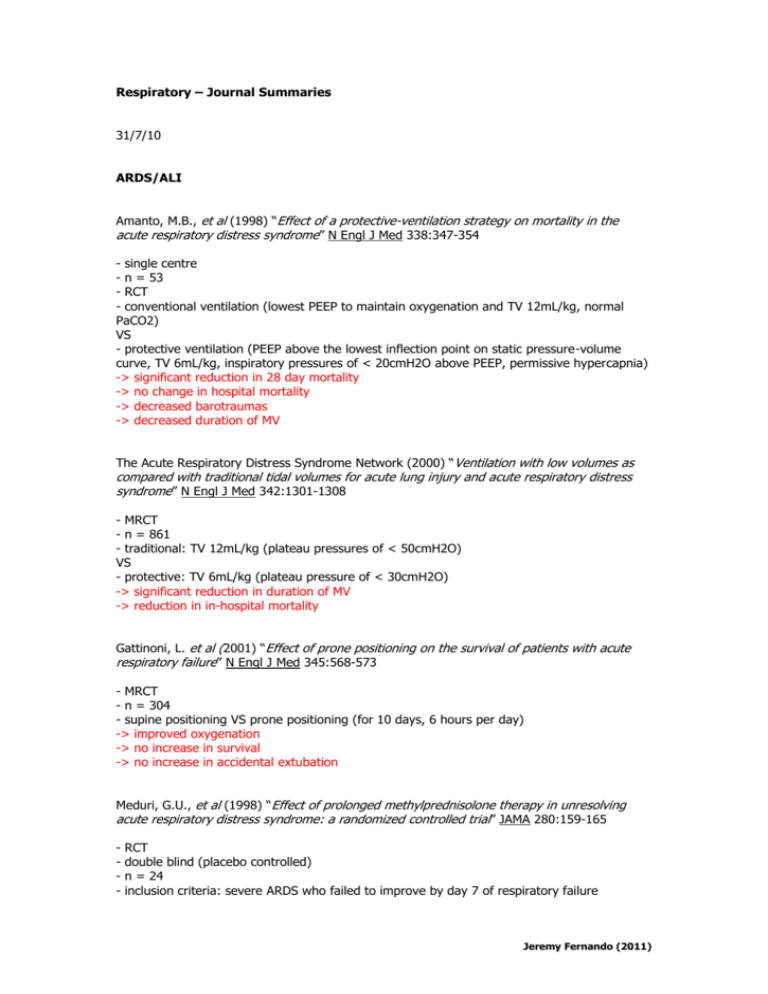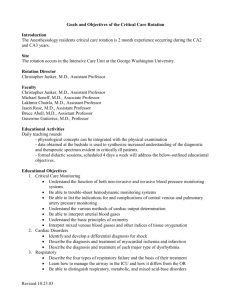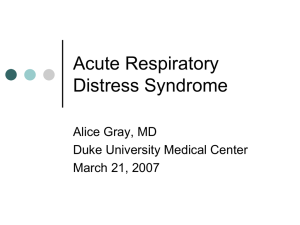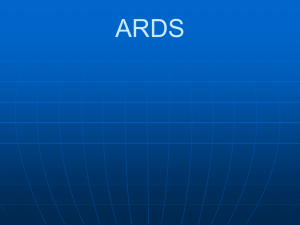Respiratory – Journal Summaries - Wellington Intensive Care Unit
advertisement

Respiratory – Journal Summaries 31/7/10 ARDS/ALI Amanto, M.B., et al (1998) “Effect of a protective-ventilation strategy on mortality in the acute respiratory distress syndrome” N Engl J Med 338:347-354 - single centre - n = 53 - RCT - conventional ventilation (lowest PEEP to maintain oxygenation and TV 12mL/kg, normal PaCO2) VS - protective ventilation (PEEP above the lowest inflection point on static pressure-volume curve, TV 6mL/kg, inspiratory pressures of < 20cmH2O above PEEP, permissive hypercapnia) -> significant reduction in 28 day mortality -> no change in hospital mortality -> decreased barotraumas -> decreased duration of MV The Acute Respiratory Distress Syndrome Network (2000) “Ventilation with low volumes as compared with traditional tidal volumes for acute lung injury and acute respiratory distress syndrome” N Engl J Med 342:1301-1308 - MRCT - n = 861 - traditional: TV 12mL/kg (plateau pressures of < 50cmH2O) VS - protective: TV 6mL/kg (plateau pressure of < 30cmH2O) -> significant reduction in duration of MV -> reduction in in-hospital mortality Gattinoni, L. et al (2001) “Effect of prone positioning on the survival of patients with acute respiratory failure” N Engl J Med 345:568-573 - MRCT - n = 304 - supine positioning VS prone positioning (for 10 days, 6 hours per day) -> improved oxygenation -> no increase in survival -> no increase in accidental extubation Meduri, G.U., et al (1998) “Effect of prolonged methylprednisolone therapy in unresolving acute respiratory distress syndrome: a randomized controlled trial” JAMA 280:159-165 - RCT double blind (placebo controlled) n = 24 inclusion criteria: severe ARDS who failed to improve by day 7 of respiratory failure Jeremy Fernando (2011) - methylpredisolone VS placebo -> reduction in ICU mortality -> reduced oxygenation requirement -> reduction in MODS score - criticisms: small numbers, differences in baseline characteristics between groups. National Heart, Lung and Blood Institute Acute Respiratory Distress Syndrome (ARDS) Clinical Trials Network – N Engl J Med 354:1671-1684 - RCT - n = 180 - randomised after 7-28 days - placebo VS methylprednisolone -> no difference in 60 day mortality -> increased death rate in those commenced on steroids after 2 weeks -> no increase in nosocomial infections -> trend towards increased neuromyopathy -> increase in number of ventilator-free, ICU and free days in the first 28 days after treatment National Heart, Lung and Blood Institute Acute Respiratory Distress Syndrome (ARDS) Clinical Trials Network. (2006) “Comparison of two fluid-management strategies in acute lung injury ” N Engl J Med 354:2564-2575 - RCT = n = 1000 - conservative VS liberal fluid strategy -> no difference in 60 day mortality -> in conservative group: improved respiratory function, reduced duration of MV, no increase in non-pulmonary failures - criticisms: high exclusion rate (no CHF, young patients), patients enrolled @ 24 hours -> what to do early in admission is unanswered Taylor, R.W. et al (2004) “Low-dose inhaled nitric oxide in patients with acute lung injury: a randomized controlled trial” JAMA 291:1603-1609 - MRCT - n = 385 - 5 ppm of NO VS placebo -> improved oxygenation -> no reduction in mortality -> no reduction in MV Agarwal R, Nath A, Aggarwal AN, Gupta D. “Do glucocorticoids decrease mortality in acute respiratory distress syndrome? A meta- analysis.” Respirology 2007;12:585-90. -> current evidence does not support the efficacy of steroids in ARDS Meduri G, Marik P, Chrousos G, Pastores S, Arlt W, Beishuizen A, et al. Steroid treatment in ARDS: a critical appraisal of the ARDS network trial and the recent literature. Intensive Care Med 2007 Jeremy Fernando (2011) -> prolonged glucocorticoid treatment substantially and significantly improves meaningful patient-centered outcome variable and has a distinct survival benefit Steinberg KP, Hudson LD, Goodman RB, et al: National Heart, Lung, and Blood Institute Acute Respiratory Distress Syndrome (ARDS) Clinical Trials Network: Efficacy and safety of corticosteroids for persistent acute respiratory distress syndrome. N Engl J Med 2006; 354:1671-1684. - n = 180 - MRCT - methylprednisolone for 14 days with taper VS placebo -> reduced shock symptoms -> reduced ventilator days -> improved pulmonary compliance -> NO improvement in survival -> increased mortality in patient who had had steroids > 14 days -> increased neuromuscular weakness What about steroids for ARDS prophylaxis? - increase in ARDS and subsequent mortality (weak trend) Summary - exact place of steroids in ARDS is unknown - further investigation required VENTILATOR ACQUIRED PNEUMONIA Drakulovic, M.B., et al (1999) “Supine body position as a risk factor for nosocomial pneumonia in mechanically ventilated patients: a randomised trial ” Lancet 3541851-1858 - n = 86 - single centre - supine VS semirecumbent -> study stopped at interim analysis c/o significant reduction in pneumonia in the semirecumbent -> risk factors for pneumonia = supine position + enteral nutrition Fagon, J.Y., et al (2000) “Invasive and non-invasive strategies for management of suspected ventilator-associated pneumonia. A randomized trial” Ann Intern Med 132:621-630 - MCT - n = 413 - inclusion criteria: ventilator-associated pneumonia - intervention = invasive management (direct bronchoscopy + larvage -> cultures and cessation of antibiotics if negative) VS non-invasive management (standard tracheal aspirates and empirical treatment) -> reduced mortality in invasive group (14 and 28 days) -> reduced antibiotic group in invasive group Jeremy Fernando (2011) VENOUS THROMBOEMBOLISM Geerts, W.H., et al (2004) “Prevention of venous thromboembolism: the Seventh ACCP Conference on Antithrombotic and Thrombolytic Therapy” Chest 126:338-400 - detailed guidelines on the prevention of VTE - there is an absence of data in the critically ill Konstantinides, S., et al - Management Strategies and Prognosis of Pulmonary Embolism – 3 Trial Investigators. (2002) “Heparin plus alteplase compared with heparin alone in patients with submassive pulmonary embolism” N Engl J Med 347:1143-1150 - double blind RCT - n = 256 - acute PE and PHT or RV dysfunction (not with hypotension) - heparin VS heparin + alteplase -> reduces clinical deterioration -> reduced need for interventions (CPR, emergency embolectomy, catheter thrombosis fragmentation) -> no fatal bleeding in lysis group -> did not change inhospital survival -> consider thrombolysis in sub-massive PE The PROTECT Investigators for the Canadian Critical Care Trials Group and the Australian and New Zealand Intensive Care Society Clinical Trials Group (2011) – Dalteparin vs Unfractionated Heparin in Critically Ill Paitients – NEJM, March - MRCT n = 3764 adults primary end-point: proximal DVT assessment by twice weekly U/S -> -> -> -> -> -> overall incidence proximal DVT incidence of 5.6% no difference in rates of proximal DVT between groups most DVT’s occur in ICU (not the ward) decreased PE rate in dalteparin group (NNT 100) no difference in bleeding no difference in HITS (trend to decrease with dalteparin) MISCELLANEOUS Naveanu, M. et al (2010) “Effect of oral beta-blocker on short and long term mortality in patients with acute respiratory failure: results from the Basel II-ICU study” Critical Care, 14:1-10 - sub-study of an MRCT looking at BNP in the guidance of acute respiratory failure (BNP for Acute Shortness of Breath Evaluation II-ICU trial) - 7 ICU’s - Switzerland - n = 314 - inclusion criteria: admission to ICU with respiratory failure Jeremy Fernando (2011) - exclusion criteria: trauma, severe renal disease, previous BNP, > 12 hours of eligibility, sepsis, CPR, shock. - randomized to BNP measurement vs no BNP measurement -> in hospital mortality 16% -> one year mortality 41% -> renal dysfunction, IHD, malignancy associated with increased mortality -> oral beta-blockers on admission or started during admission was associated with a lower risk of death (in hospital and at 1 year irrespective of whether respiratory failure cardiac or not) -> discontinuation of beta-blockers associated with higher mortality Weaknesses - mechanism uncertain - post-hoc analysis - not generalisable to sepsis or shock -> shown to decrease mortality in COPD, heart failure, IHD, HT and now respiratory failure in ICU Jeremy Fernando (2011)







